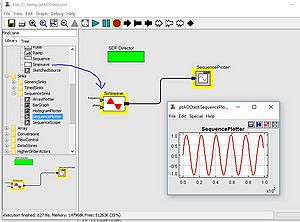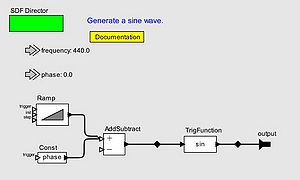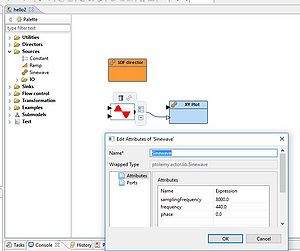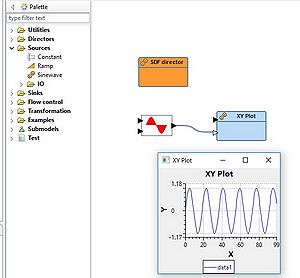Notice: this Wiki will be going read only early in 2024 and edits will no longer be possible. Please see: https://gitlab.eclipse.org/eclipsefdn/helpdesk/-/wikis/Wiki-shutdown-plan for the plan.
Triquetrum/Actor Oriented Classes
Contents
Implementing and using Actor Oriented Classes in Triquetrum
Ptolemy II [1] models define actor assemblies that can be executed in different Models of Computation.
Actors can be implemented in different ways. Most Ptolemy II actors are implemented in Java, but other languages like JavaScript, Python, C have also been used. A different approach is to implement actors as composites of contained actor assemblies, or as "submodels". These are called "Actor Oriented Classes" [2].
In Ptolemy II's Vergil model editor, existing AOC implementations can be handled in a similar way as "programmed" actors. Ptolemy II is able to load both Java-based actor classes and MoML-based AOCs from the classpath, show them in the actor palette/library, let users drag-n-drop them on a graphical model canvas, connect ports, configure parameters etc.
AOCs can also be created using Vergil and can then be shared between "consumer models", either via the concept of a "User library" or by adding them to the classpath (e.g. by adding them in the Ptolemy II build or by copying them on the root installation folder). There is no explicit tool support to share models between multiple users.
With issue #78, the goal is to implement support for AOCs in Triquetrum.
This requires some reflection on different levels :
- How can we create AOC models? E.g. first designing a plain model and then mark it somehow as a "reusable AOC"? Or should this be a specific wizard/workflow in the editor upfront?
- Where do we store AOCs so they can be used for designing and running "consumer models"? Linked to this, how can we share them easily between models and with other users?
- How to represent AOCs within parent/consumer models? Vergil shows a customizable actor icon and via an "Open actor" action the user can see the internal details of the AOC model in a separate editor window. In Graphiti it's not straightforward to navigate between diagrams/windows from a parent model. This is related to the tight integration between diagram editors and underlying EMF resources. So e.g. Kieler/ELK use another paradigm where they expand/collapse the contents of a submodel within the same diagram (minimizing the remainder of the surrounding model).
- Do we want to support the difference between AOC classes and instances, similarly to Ptolemy II? And if so, also subclassing and other advanced features related to using AOCs in Ptolemy II?
The work will be done in several steps :
- Add support for using existing AOCs in the Triquetrum editor. At this stage we depend on using Vergil to implement AOCs.
- include AOCs in the editor palette configuration
- define a common approach for storing/loading AOC classes for the editor and for a headless workflow runtime
- always use AOC instances in our models, we will not be storing AOC class definitions inside models.
- simple representation of an AOC in a model with similar configuration options as for a Java-based actor
- figure out a way to dynamically add AOCs to an existing Triquetrum installation
- extend this to allow opening the AOC model details in a readonly view
- Add support for creating AOC models in Triquetrum
- graphical models and DSLs?
- AOCs defined within a parent model or only as separate models, meant to be used as "reusable submodels"?
- classes, subclasses, instances?
Using existing AOCs in Triquetrum
Ptolemy II's Sinewave actor is a typical AOC to try things out. It can be found as a SequenceSource in Vergil's editor palette. When connecting it to a SequencePlotter it generates a nice sine wave.
Sinewave is implemented as an AOC, and its internal model can be viewed in Vergil :
Using an ActorOrientedClassProvider
Standard Ptolemy II loads Java and AOC actor classes from its classpath. In a managed modular environment such as OSGi (and thus Triquetrum) this is less desirable as an approach. To prepare for Triquetrum (or other OSGi-based runtimes) Ptolemy II has been adapted to provide an API and implementation to load AOCs (and Java actor classes) using different strategies.
By plugging in org.ptolemy.classloading.osgi.OSGiClassLoadingStrategy as the implementation of org.ptolemy.classloading.ClassLoadingStrategy, Ptolemy becomes capable of exploiting OSGi services and all their interesting features for modularity and dynamic extensions.
Both Ptolemy II's own ptolemy.moml.MoMLParser and Triquetrum's editor use the ClassLoadingStrategy approach to find actor classes.
The OSGiClassLoadingStrategy implementation tracks all registered OSGi services that implement one of two interfaces :
- org.ptolemy.classloading.ModelElementClassProvider : provides Java actor classes from OSGi bundles. Implementations are already available and used for providing the default actor library and to allow easy addition of new actors to a Triquetrum editor/runtime (see also https://wiki.eclipse.org/Triquetrum/Extending_Triquetrum)
- org.ptolemy.classloading.ActorOrientedClassProvider : no implementation yet. This needs to be done to get a first level of AOC support working in Triquetrum.
So a first step for supporting AOCs in Triquetrum involves :
- implementing an ActorOrientedClassProvider that is capable of loading existing AOC implementations
- making these AOCs available to the Triquetrum editor via the palette configuration
- ensuring that a model designer can use AOCs in the same way as Java-based actors
- ensuring that such models also execute correctly
Loading AOCs from a filesystem
Our first AOCProvider implementation is based on finding AOCs via the WorkflowRepositoryService. We'll integrate org.eclipse.triquetrum.workflow.repository.impl.filesystem.WorkflowRepositoryServiceImpl, which uses the local filesystem to store/load models for this first implementation. The AOCProvider implementation can be found in org.eclipse.triquetrum.workflow.aoc.repository.AocProviderFromRepository.
- Integrating this file-based repository in the editor is a good trigger to provide a first preferences page, to be able to configure the root folder of the repository (cfr issue #183).
We've followed the approach described by Philip Wenig on the OpenChrom blog (thanks!) to work with preferences in a consistent manner [3].
Adding AOCs in the editor palette
Now that we can load AOCs, we can also add them to the editor palette. E.g to add the Sinewave actor :
<entry class="ptolemy.actor.lib.Sinewave" (1) displayName="Sinewave" icon="icons/SinewaveIcon.xml" (2) iconType="ptolemy" type="CompositeActor"> (3) </entry>
(1) : the fully qualified class will be passed to the repository service, and that one should be able to load the AOC class definition XML file based on that. (2) : AOC actors can also get custom icons, e.g. based on Ptolemy II's icon definitions as in this case. Icon files should be added in the palette configuration bundle as well (cfr https://wiki.eclipse.org/Triquetrum/Extending_Triquetrum#Defining_the_palette_entry). (3) : AOCs are CompositeActors, it's important to set this as correct entry type.
Configuring an AOC in a model
The Sinewave actor can be configured in exactly the same way as a standard Java-based actor. But now you see the AOC "model" parameters only, not each individual parameter of each contained atomic actor (see the internal view on the Sinewave model, above).
Running a model with an AOC
When running this model, it behaves similarly as the Ptolemy II implementation :
[1] http://ptolemy.eecs.berkeley.edu/ptolemyII/
[2] http://ptolemy.eecs.berkeley.edu/publications/papers/04/Classes/Lee_Classes.pdf
[3] https://openchrom.wordpress.com/2014/01/11/how-to-handle-preferences-consistently/




